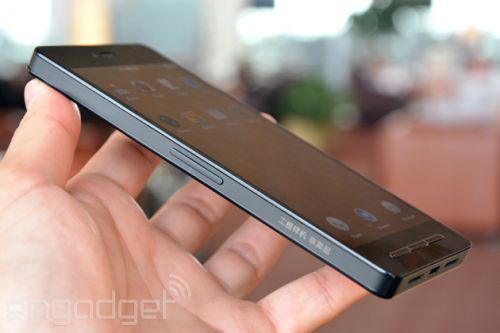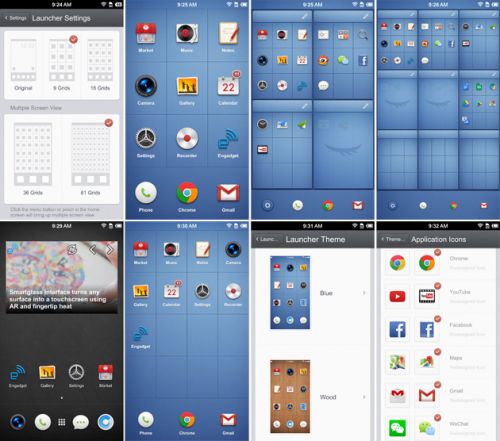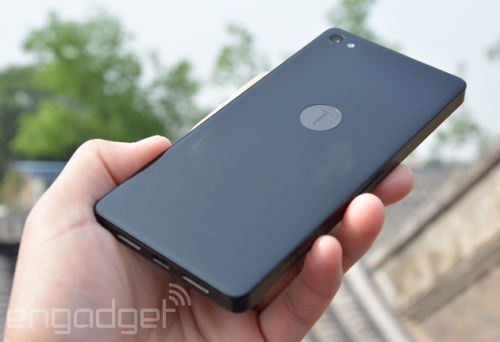

元器件交易网讯 5月23日消息,罗永浩发布锤子后引起业界广泛讨论,外媒Engadget刊文,称老罗的锤子是一款来自中国、“惊艳而独特”的高端安卓智能机。
文章用大篇幅罗列锤子的硬件特性、外观构造并大家赞赏,一反外媒对锤子ROM的失望态度,并表示“T1让人惊喜:它与来自小米、一加、努比亚及其他中国年轻品牌或高端、或低端的智能机不同,T1并不平价;它的定位是与众不同的高端智能手机。”
以下为文章内容:
与目前大部分旗舰机一样,T1配备了一块JDI(日本显示器公司)生产的5英寸1080p IPS显示屏,正反面均使用第三代大猩猩玻璃。内置一枚四核2.5GHz骁龙801芯片,2GB内存,容量16GB、32GB可选(不支持microSD扩展),搭配2570mAh电池和降噪麦克风。支持802.11ac无线、蓝牙4.0、GPS、NFC和3G频段。3G版将在7月上市(售价3000元人民币,约480美元),4G版本将在年底推出(售价3500元人民币,约560美元)。锤子并不是那种典型的中国廉价机,而且价格也不坑爹。
摄影方面,1300万像素f/2.0大光圈摄像头(配索尼IMX214传感器),前置摄像头500万像素。CEO罗永浩强调,他与其他厂商相比,最大的不同在于与影像团队合作非常密切。锤子采用富士通AcuteLogic自动白平衡软件和ArcSoft场景识别及降噪技术。夜间模式采用六连拍再组合模式,最终生成一个影像以减少噪点。锤子的全景模式也很便捷,可以在180度和360度模式间自如切换。

老罗对T1的音质也颇为自傲。T1使用TI的OPA2604运放芯片,工程师们将音频响应与低失真相结合,声称与针对音乐发烧友的Xplay 3S性能相近。Xplay 3S同样使用TI的OPA2604并增加DAC芯片,因此占据了逻辑板上的空间,功率消耗和产生的热量均增加。T1在使用更少的硬件的同时拥有相同的表现,这一点令人印象深刻。我们已经测试过这款机器,禁用“Hi-Fi”模式时效果更好,清晰的音质可以更好的表现声场,且低音并不咄咄逼人。老罗表示得到了两位中国著名的音乐制作人的帮助(张亚东、左小祖咒),并欢迎所有音乐爱好者测试。
锤子重量为167克,厚度为8.23毫米,并没打算在这方面做出什么惊人之举,而在软件方面进行突破。但并非表明锤子在硬件方面有所懈怠。老罗在硬件和包装方面都采用简洁元素,并得到了苹果公司前首席设计师罗伯特·布伦纳的帮助。罗伯特的Ammunition工作室业务包括:Beats品牌和产品、巴诺的Nook平板电脑、宝丽来的Cube和Adobe的Mighty项目、Napoleon项目。同时锤子纸质包装盒的原料来自詹姆斯·克罗帕——

锤子T1正反面均以玻璃为主,覆盖率达83.8%。后盖可自行拆卸,也可以更换彩色电池版本,并提供刻字服务。从侧面可以看到三层结构,玻璃纤维层夹在及玻璃面板和光滑的塑料框架之间。这种结构基本与iPhone 4和4S类似,但用金属框架代替了塑料框架。
同时T1采用与iPhone 4/4S相似的后盖锁扣设计,底部同样采用两枚螺丝(提供两枚备用螺丝)固定。为了隐藏SIM卡插槽而这样设计在使用上极不方便,但老罗强调他不希望SIM卡插槽破坏框架的简洁性,而且大部分人每年仅更换SIM卡一次。

锤子T1有黑白两种版本,为减少白色版本表面的黑点色块,近场环境传感器都被隐藏在顶部的听筒附近,可以看到的只有前置摄像头;底部采用三枚物理按键来取代触控光点。老罗认为物理按键较
T1的设计十分讲求对称。微型USB端口和音量、亮度调节键平衡分布在手机两侧。右上角的圆形电源按钮与左上角的耳机插孔对称,底部的微星USB接口与扬声器对称。

真正的差异化的T1是其独特的Smartisan操作系统软件。九宫格设计相较大多数安卓版本还是比较顺眼的。但有需要指出的一点是,虽然可以设置一个图片作为锁屏壁纸,但主屏壁纸不可更换,因为锤子坚持外观整洁。

T1在中国7月上市,但在国外目前还没有推广计划。对于未来老罗表示一年或两年之后才会在海外推出产品,还会亲自上演中英双语主题演讲。对于一个用两年时间造出一个与众不同产品的男人来说,一切皆有可能。(元器件交易网毛毛 摘译)
以下为原文:
A little over a year ago, a fresh Chinesestartup by the name of Smartisan ("smart" and "artisan"combined) showed off its first work: the Android-based Smartisan OS. Whatcaught our attention was its truly unique UI and insanely thoughtful UXfeatures, so naturally, we had very high expectations for the company's ownhardware back then. At long last, the Smartisan T1 phone was unveiled in frontof some 5,000 people -- along with 2.74 million online viewers -- at the two-hourlong event earlier this week, and despite the usual flagship-level specs, itwas still full of nice surprises. Don't be mistaken: unlike the low-cost,high-end devices from Xiaomi, OnePlus, Nubia and other young Chinese brands,the T1 isn't about affordability; it's positioned as a more premium smartphonewith much more differentiation. How so? Read on to find out.
Let's get the boring specs out of the wayfirst. Like most flagship phones these days, the T1 packs a 5-inch 1080p IPSdisplay by JDI, Gorilla Glass 3 on both the front and back, a powerful 2.5GHzquad-core Snapdragon 801 SoC, 2GB of RAM, 16GB or 32GB of internal storage(sorry, no microSD expansion here), a fixed 2,570mAh battery and anoise-cancelling secondary microphone. For the wireless part, you get the usual802.11ac WiFi, Bluetooth 4.0, GPS, NFC and AT&T-friendly 3G bands. The 3Gversion will arrive in China first come July (from CN¥3,000 or about $480),followed by a 4G version by end of year (from CN¥3,500 or about $560). That'sright, this isn't your typical cheap Chinese phone, but the price points arestill not bad.
Photography shouldn't be a problem with the13-megapixel f/2.0 camera (featuring Sony's IMX214 sensor) and the 5-megapixelselfie camera. CEO Luo Yonghao stressed that his imaging team collaborated veryclosely -- more so than most other manufacturers have, apparently -- withFujitsu, who also convinced Smartisan to adopt AcuteLogic's auto white balancesoftware and ArcSoft's scene recognition plus noise reduction technology. We'remost interested in the camera app's night mode, which takes six consecutiveshots and combines them into one to reduce noise. The panorama mode is alsohandy, as it lets you toggle between 180-degree mode and 360-degree mode. Asthe unit we've been given was still running on beta software, we'll save ourcamera impressions for later.
Luo also boasted the T1's audioperformance. By using just TI's OPA2604 op-amp chip, his engineers were able toachieve an audio frequency response plus low distortion that claim to be almostidentical to that of the Vivo Xplay 3S, a recently launched Chinese phone aimedat audiophiles. For those who aren't familiar, the Xplay 3S uses an extra DACchip alongside the same OPA2604 amplifier, thus taking up more space on thelogic board, consuming more power and potentially producing more heat; so it'simpressive that the T1 has a matching audio performance using less hardware.We've had a good listen with our unit and it definitely sounds better than withthe "Hi-Fi" mode disabled: the sound stage is more apparent thanks togreater clarity, and the bass is more lively yet not aggressive. Luo added thathe had help from two famous music producers in China, and he welcomed all audioenthusiasts to give his phone a serious test drive.
At 167g heavy and 8.23mm thick, Smartisan'sfirst smartphone isn't exactly gunning for any record-breaking title, whichisn't a surprise given the heavy focus on the software side; but that's not tosay the company did a lazy job on the hardware. Here, Luo took a minimalisticapproach with both the phone plus the packaging, and he had help from Apple'sex-lead designer, Robert Brunner, who now runs Ammunition in San Francisco. Thestudio's work include the Beats branding and products, Barnes & Noble Nooktablets, the Polaroid Cube and Adobe's Project Mighty plus Project Napoleon. Itshould also be pointed out that the elegant box is made by James Cropper, a169-year-old fine paper specialist firm from England.
The device is dominated by glass across theentire front and back sides, thus covering 83.8 percent of its exterior. Theremovable back cover -- which can be swapped with a slightly thicker batterycover for extra juice -- also features subtle bevels that add character to itsglass polish. On the sides, you can see the simple three-layer sandwich formedby the flat fiberglass frame in the middle, as well as the glass panels' glossyplastic frames. It's essentially the same sandwich layout as the iPhone 4 and4S, except here the metal frame is flush with the plastic frames.
On a related note, the T1 and the iPhone4/4S share a similar back cover locking design: you push it up to pop it off,and you secure it with two screws at the bottom (there are also two sparescrews provided). This may seem a rather inconvenient way of hiding the MicroSIM slot underneath, but Luo reasoned that he didn't want to have a SIM trayruining the clean surface on the mid-frame, plus most people only change SIMcards once a year. Obviously, that doesn't apply to road warriors like many ofus here at Engadget, but the good news is so far, our back cover still stayssecure without the screws, though only time will tell whether it'll becomeloose.
The T1 comes in either black or white. Forthe sake of reducing the number of black dots on the white version, theproximity and ambient sensors are housed within the same tiny groove as theearpiece at the top, leaving just the front-facing camera right next to them.Alas, the other end of the panel doesn't look as clean no thanks to the threephysical buttons, albeit each being marked with just one tiny light dot.Smartisan chose these as it believes capacitive buttons are more prone toaccidental clicks, which we don't entirely agree with; and not to mention theirony of how these rounded keys bulge out as well. On a more positive note, youcan swap the menu button and the back button around in the system settings menu(which unfortunately does look like the one in the earlier versions of iOS), soit doesn't matter whether you're left-handed or right-handed.
The T1's design carries heavy emphasis onsymmetry. The micro-USB port and the two sets of customizable rocker keys (onefor volume and one for brightness) are all centered on their respective sidesof the phone. The circular power button near the top right corner mirrors theheadphone jack on the top left; and likewise with the speaker grills on bothsides of the micro-USB port at the bottom (even though the one on the right isjust a dummy, as the loudspeaker and the microphone are tucked inside the leftone).
The black pre-production unit (at stage"P4.5") we received already looks and feels good, though Luo didpoint out that the final version will use a black micro-USB socket instead ofthe white one on our device. That's how OCD he is. The only downsides we'venoticed so far are the relatively heavier weight (which arguably also gives amore premium feel), plus the glass panels' inevitable susceptibility tofingerprints. We could complain about the lack of a curved back that would haveprovided a more comfortable grip, but on the other hand, we do welcome the moresecure grip courtesy of the flat composite frame, as opposed to the annoyingslipperiness on the latest
The real differentiator for the T1 is itsunique Smartisan OS software. For those who aren't familiar with this AndroidROM, its home screen comes with 3 x 3 grid panels plus a three-item dock bydefault, which is more pleasing to the eye than most other Android launchers.We also dig how the tiles animate every time you unlock the phone, move an iconaround or change the launcher's theme. When you pinch the page or hit the menubutton, you can zoom out to either a 6 x 6 view or a massive 9 x 9 view, whereyou can directly launch an app, move an app to another panel, rearrange thepanels, hide them or lock them. You can also switch to a 4 x 4 grid layout oreven back to the conventional, grid-less Android home screen, though the latterwould kind of defeat the purpose of using Smartisan OS.
One interesting point to make is that whileyou can set a photo as the lock screen wallpaper, you can't do the same forhome screen wallpaper, as Smartisan insists on keeping the launcher look clean.You do, however, have several theme options: black, gray, blue, wood, purple,rock, leather and brown. Just when you think there's limited UI customizationhere, note that the ROM is kind enough to let you toggle between its customicons and the original icons for select apps. There are even some"OCD" settings -- all disabled by default -- if you want to toggleminor things like icon labels, battery percentage, icon notification badges anda full-screen swipe-up gesture that clears said badges.
The "smart" in Smartisan OS isall about how it solves the many pain points that we come across while usingour smartphones. You can check out a detailed list of features in our previousarticle, so we'll focus on the new ones introduced at this launch event, aswell as some of our favorites here. Most notably, there's another reason forwhy the T1 comes with two sets of rocker keys: you can squeeze both at any time-- even when on standby -- and then let go to instantly take a photo! It'spretty much just a one-step process, as opposed to having to wake the phone andthen launch the camera app to hit the capture button. The problem with thishandy feature is that it currently doesn't focus in advance, so here's hopingthe final software will have this fixed.
There are a couple of noteworthygesture-based features as well. One of them is a downward thumb swipe to pullthe entire screen down, so that everything is within your thumb's reach.Another cool one is you can trigger a screen rotation at any time by using boththumbs to draw a circle, in the direction of your desired rotation. This comesin rather handy when you're lying on a side, where auto rotation becomes moreof a nuisance than convenience.
Other goodies include: the ability tocreate a calendar event from a received text message (date and time areautomatically recognized, if mentioned); the option to crop screenshots rightafter capture; disable lock screen password when connected to your desiredpassword-protected WiFi network (based on the work of jailbroken iOS appCleverPin); text messaging scheduler; and a system-wide mute timer (up to eighthours) in the volume panel. There are also some fun bits like intentionallyout-of-sync second hands on the world clock page (but you can shake to syncthem), and the turntable arm in the music app lets you fast forward or rewindmusic (Luo is also considering adding disc-scratching function here).
We can go on and on with the list offeatures. What's certain is that an insane amount of thought has been put intoboth the hardware and the software, making the T1 a truly unique and passionateproduct. But that's not all. Instead of buying a case for the sake ofprotecting your T1, you can pay CN¥200 or about $30 -- a bit less than thetypical price of a nice case -- for a "SmartCare+" warranty, whichoffers two free front or back panel replacements within a year. But if youprefer the old fashioned way, Smartisan will also be selling a bumper case forits phone.
In terms of availability, the T1 will beshipping in China come July, but there aren't any plans to launch it outsidethe country just yet, so interested folks elsewhere will have to rely on eithera resident of China or an importer. Looking ahead, though, Luo told us that heplans to eventually launch a phone overseas in about a year or two, and he'lleven personally host the keynote in English. For a man who went from zero tolaunching such an eccentric phone in just over two years, anything is possible.
关注我们

公众号:china_tp
微信名称:亚威资讯
显示行业顶级新媒体
扫一扫即可关注我们